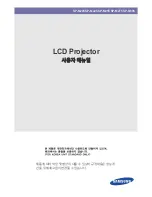
X G - E 6 9 0 U B ( E ) / p p . 1 3 - 1 6
G. K . A s s o c i a t e s , To k y o
E-13
When displaying computer patterns which repeat every other dot (tiling,
vertical stripes, etc.), interference may occur between the LCD pixels,
causing flickering, vertical stripes, or contrast irregularities in portions of
the screen. Should this occur, use the ADJUSTMENT
ß
/
©
buttons on the
remote control for HORIZONTAL (LEFT/RIGHT) and VERTICAL
(UP/DOWN) POSITION ADJUSTMENTS to adjust for the optimum picture.
RGB INPUT ADJUSTMENTS (CLOCK, PHASE, V-POS
and H-POS)
1. Select RGB with the INPUT SELECT button on the
remote control and press the MENU button to
select the RGB INPUT ADJ. mode.
With the MENU screen displayed, press the
ƒ
/
∂
buttons to select RGB
INPUT ADJ. Then press the MENU button to display the RGB INPUT ADJ.
screen.
2. Select the item you wish to adjust with the
ƒ
/
∂
buttons. Adjust the item with the
ß
/
©
buttons.
3. Press the MENU button anytime to exit RGB
INPUT ADJ.
Description of Adjustment Items
INITIAL RESET
• Used to reset the H-POS, V-POS, PHASE and CLOCK adjustments to
their initial settings.
MODE ADJUSTMENT
Connecting to IBM-PC Computers
• Ordinarily, the type of input signal is detected and the correct resolution
mode (Text or Graphics) is automatically selected. However, for the
following signals, set MODE to ON or OFF to select the projector’s
resolution mode to match the computer display mode properly.
720 dots
2
400 lines, 720 dots
2
350 lines (Text Mode)
640 dots
2
400 lines, 640 dots
2
350 lines (Graphic Mode)
• For graphic mode, select MODE and set the MODE to ON.
• For text mode, select MODE again at this time, and set MODE to OFF.
Connecting to Macintosh LC/II Series Computers
• When connecting to a Macintosh II with 30.24 MHz Dot Frequency,
select MODE and set MODE to ON.
• When connecting to a Macintosh LC Series computer with 31.33 MHz
Dot Frequency, set MODE to OFF.
• When connecting to third party video cards and other Macintosh
computers, set MODE to ON or OFF to select the correct display mode.
• When the input signal is automatically detected or when there is no input
signal, MODE (---) appears on the screen and the display mode cannot
be changed.
PHASE ADJUSTMENT (UP/DOWN)
• Used to reduce image distortion or improve contrast.
HORIZONTAL POSITION ADJUSTMENT (LEFT/RIGHT)
• If on-screen images are too far to the left or right, they can be moved to
the center.
VERTICAL POSITION ADJUSTMENT (UP/DOWN)
• If on-screen images are too high or low, they can be moved to the
center.
CLOCK SPEED ADJUSTMENT (FAST/SLOW)
• Used to reduce image distortion or improve contrast.
INPUT ADJUSTMENT
Q
Filter switch
In the case of very detailed computer patterns which repeat every other
dot (tiling, vertical stripes, etc.), noise may appear on the screen. Should
this occur, set the FILTER switch to ON. The pattern area will balance, and
the noise will be reduced.
Notes:
1) Flickering, vertical stripes, or contrast irregularities may also occur when the image is reversed. Once again, use the
ADJUSTMENT
ß
/
©
buttons on the remote control for HORIZONTAL (LEFT/RIGHT) and VERTICAL POSITION
ADJUSTMENTS (UP/DOWN) to adjust for the optimum picture.
2) Avoid displaying computer patterns which repeat every other line (horizontal stripes). (Flickering will occur, making the
picture hard to see.)
INPUT
OUTPUT
COMPUTER
RGB
OFF
ON
FILTER
Q
M O D E ( - - - )
R G B I N P U T A D J .
: S E L . : A D J . M E N U : E N D
C L O C K
V - P O S
P H A S E 0
R E S E T
H - P O S
RGB Adjustment Controls
2
1 9 9 8 / 5 / 2 1













































